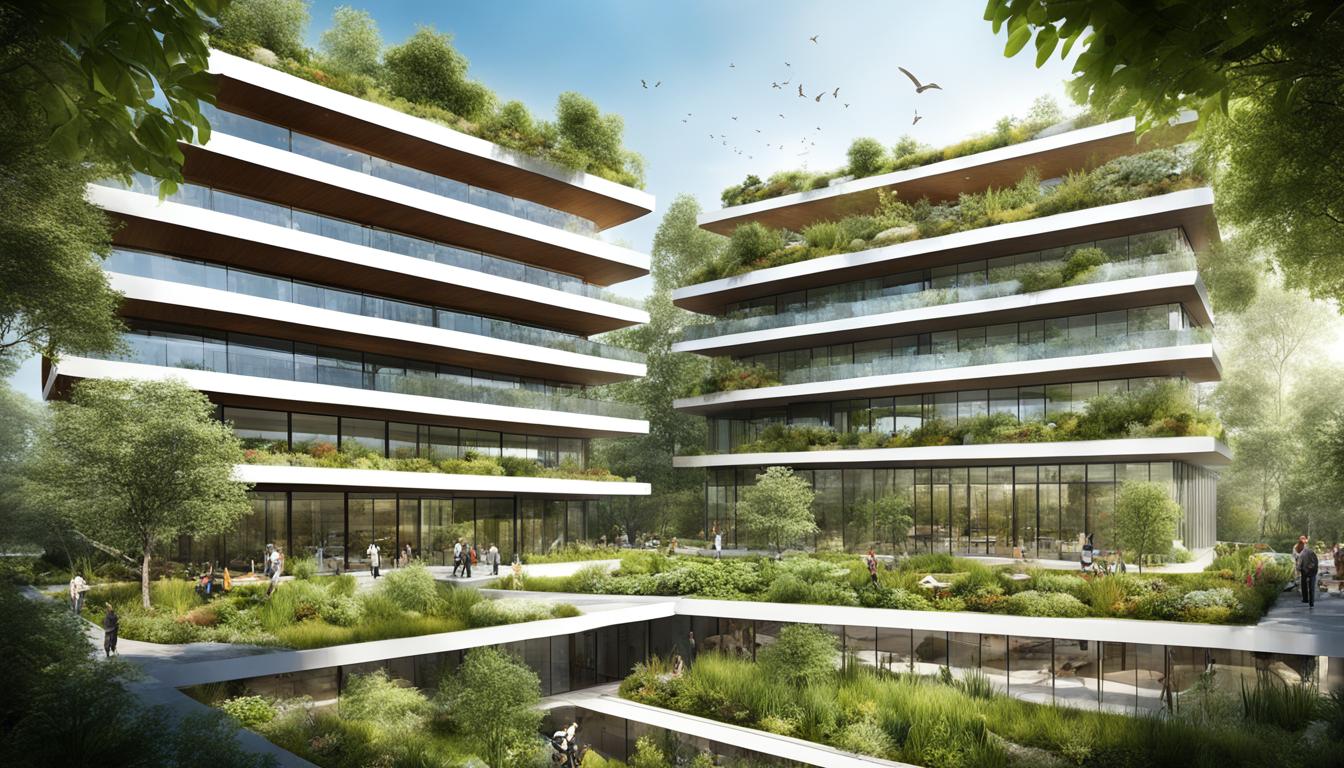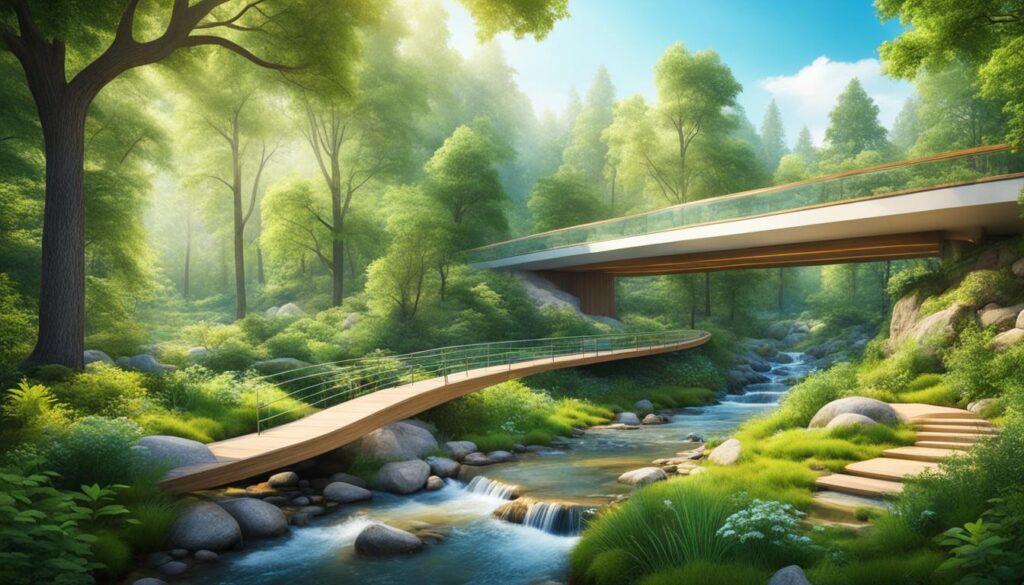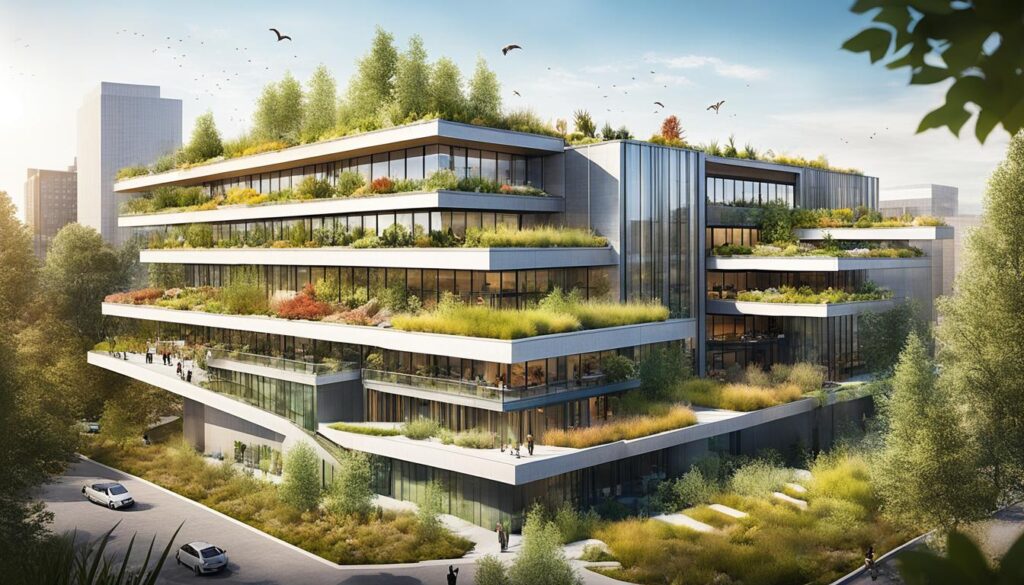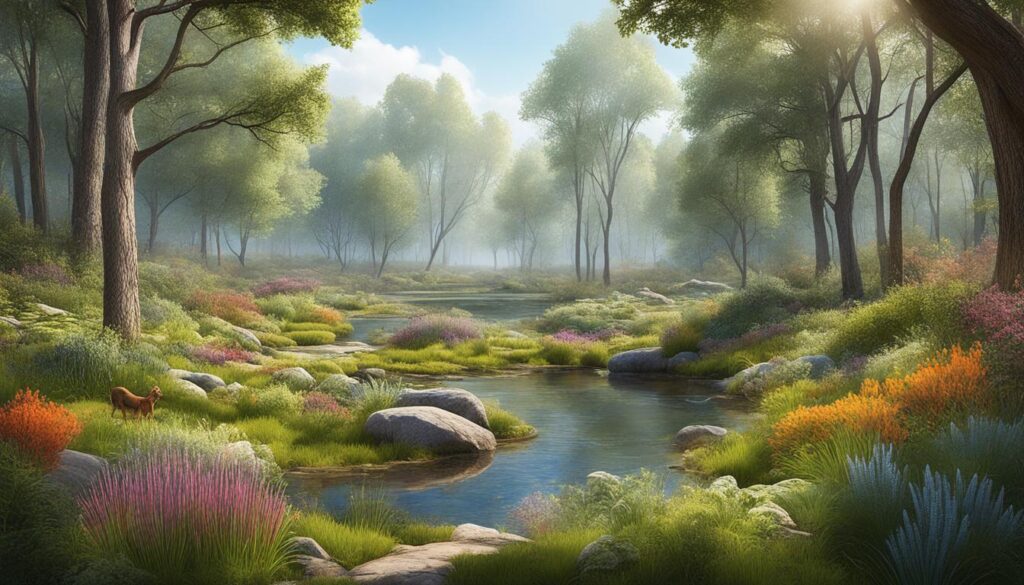
Imagine walking through a bustling city, surrounded by towering buildings and bustling streets. As you make your way through the concrete jungle, something catches your eye—a lush rooftop garden brimming with vibrant flowers and buzzing with the sounds of bees and butterflies.
This oasis in the heart of the city is a prime example of biodiversity-friendly architecture, where eco-friendly building design and sustainable construction practices come together to create a thriving ecosystem. This green infrastructure solution not only enhances the beauty of the urban landscape but also provides a sanctuary for wildlife in an otherwise concrete-dominated environment.
Architects and designers play a pivotal role in environmental conservation, using their expertise to create nature-inclusive architecture and sustainable urban planning. By incorporating elements such as native plants, wildlife-friendly building design, and green infrastructure, they can transform our cities into havens for biodiversity while preserving the essence of modern design.
In this article, we will explore the importance of architectural solutions for biodiversity conservation and delve into the ways in which design can contribute to a greener, more sustainable future.
Key Takeaways:
- Architectural solutions for biodiversity conservation involve incorporating eco-friendly design practices and green infrastructure solutions.
- Nature-inclusive architecture promotes the preservation of native plant species and provides habitats for wildlife.
- Sustainable urban planning focuses on creating environments that balance human needs with the protection of natural ecosystems.
- Designers have a crucial role in promoting and implementing environmentally conscious practices to enhance biodiversity in our built environment.
- By prioritizing nature-inclusive design, we can create harmonious spaces that support both human well-being and environmental conservation.
The Benefits of Nature-Based Solutions for Biodiversity Conservation
The research conducted by the ASLA Fund demonstrates the vital role of nature-based solutions in addressing the biodiversity crisis. Implementing these solutions through landscape architecture not only enhances and restores biodiversity but also promotes human well-being. By designing diverse landscapes and incorporating native plants, landscape architects can mimic the natural environment, creating functional diversity and complex structures that support various animal and plant species.
Nature-based solutions offer numerous benefits for biodiversity conservation and the health of ecosystems. In addition to supporting wildlife, these design strategies improve water retention capabilities and enhance green infrastructure, contributing to the overall resilience of the environment.
By promoting biodiversity, nature-based solutions create a harmonious balance between human activities and the natural world. This holistic approach supports the well-being of both humans and the planet, fostering a sustainable future.
“Nature-based solutions implemented through landscape architecture provide a win-win solution for biodiversity conservation and human well-being.” – ASLA Fund
Enhancing Biodiversity Through Nature-Based Solutions
One of the key advantages of nature-based solutions is their ability to enhance and restore biodiversity. Landscape architects play a crucial role in designing green spaces that attract and support diverse species. By incorporating native plants, designers create habitats that mimic natural ecosystems, providing food and shelter for wildlife and promoting the coexistence of various plant and animal species.
Nature-based solutions also have a positive impact on water resources. Green infrastructure, such as rain gardens and bioswales, effectively manages stormwater runoff, reducing pollution and improving water quality. These features provide additional habitat opportunities for aquatic species, further enhancing biodiversity.
Benefits for Human Well-Being
Nature-based solutions not only benefit biodiversity but also contribute to human well-being. Access to green spaces and the presence of diverse plant and animal life have been linked to improved mental and physical health. Spending time in nature can reduce stress, enhance mood, and promote overall well-being.
Furthermore, green spaces designed with nature-based solutions support recreational activities, provide opportunities for education and cultural events, and offer a sense of community. These spaces become valuable assets, fostering social connections and enhancing the quality of life for individuals and communities.
Comparative Analysis of Nature-Based Solutions
| Biodiversity Conservation | Human Well-Being | |
|---|---|---|
| Enhances biodiversity | ✓ | |
| Restores natural habitats | ✓ | |
| Improves water retention | ✓ | |
| Enhances green infrastructure | ✓ | |
| Promotes mental and physical health | ✓ |
By considering and implementing nature-based solutions, landscape architects and designers can contribute to the conservation of biodiversity while promoting human well-being. The integration of these sustainable practices in urban and natural environments not only protects and enhances our natural heritage but also creates spaces that enhance the quality of life for current and future generations.

The Role of Design in Biodiversity Enhancement
Effective design plays a crucial role in enhancing biodiversity. Designing for biodiversity involves incorporating native plants, supporting pollinators, and implementing integrated pest management. By including allelopathic and companion plants, designers can create ecosystems that support a wide range of species.
Incorporating protected areas and transforming grey infrastructure into green spaces are also essential strategies for enhancing biodiversity. Designers should consider factors such as slope, building height, and architecture to create habitats that meet the needs of various species.
Additionally, community partnerships and participatory design processes that involve indigenous groups and other stakeholders promote biodiversity monitoring, stewardship, and decision-making.
Designing with Native Plants
One of the most effective ways to enhance biodiversity through design is by incorporating native plants into green spaces. Native plants have evolved to thrive in their specific ecosystems and provide habitats and food sources for local wildlife.
Using native plants in landscape designs promotes the establishment of resilient and self-sustaining ecosystems. These plants are well-adapted to local conditions, requiring less water, fertilizer, and maintenance compared to non-native species.
In addition to supporting biodiversity, native plants also contribute to green infrastructure and the overall health of the environment. They can reduce stormwater runoff, filter pollutants, and improve soil quality.
Promoting Pollinator Habitat
Supporting pollinators is another important aspect of designing for biodiversity. Pollinators, such as bees, butterflies, and birds, play a critical role in plant reproduction and ecosystem health.
Designers can create pollinator-friendly habitats by incorporating plants that provide nectar, pollen, and shelter. Flowering plants with different bloom times can ensure a continuous food source for pollinators throughout the year.
Providing nesting sites such as bee hotels and bird boxes can further enhance the habitat for these important species. By considering the needs of pollinators in design, designers can contribute to the preservation of biodiversity.
Integrated Pest Management
Integrated pest management (IPM) is a holistic approach to pest control that minimizes the use of harmful chemicals. By implementing IPM strategies, designers can reduce the negative impact on beneficial insects and other wildlife.
Designers can incorporate IPM practices by selecting pest-resistant plant varieties, creating diverse plant communities, and promoting natural enemies of pests. By avoiding the use of pesticides, designers can create healthier and more sustainable ecosystems.
Transforming Grey Infrastructure into Green Spaces
Transforming grey infrastructure such as paved surfaces or unused buildings into green spaces is a valuable strategy for enhancing biodiversity. Green infrastructure provides multiple benefits, including wildlife habitat, stormwater management, and improved air quality.
Designers can incorporate green roofs, rain gardens, and urban parks to create interconnected green spaces that support biodiversity. These green areas act as corridors, allowing wildlife to move freely between protected areas and increasing habitat availability.
Community Participation and Indigenous Knowledge
Involving local communities, including indigenous groups, in design processes is crucial for biodiversity enhancement. Community partnerships and participatory design processes provide opportunities for knowledge sharing, biodiversity monitoring, and stewardship.
Indigenous knowledge often holds valuable insights regarding local ecosystems and traditional land management practices. By integrating this knowledge into design, designers can create more sustainable and culturally sensitive solutions that enhance biodiversity.
Habitat Design Considerations
When designing for biodiversity, designers should consider various factors to create habitats that meet the needs of different species. Factors such as slope, building height, and architecture can influence the availability of food, shelter, and nesting sites.
Designers can incorporate diverse vegetation layers, including ground covers, shrubs, and trees, to provide a range of habitats for different species. Additionally, the design should consider providing protected areas such as wetlands or meadows to accommodate nesting and breeding grounds.
By understanding the specific requirements of target species and considering the surrounding landscape, designers can create habitats that promote biodiversity and long-term ecological sustainability.
| Design Strategies for Biodiversity Enhancement | Description |
|---|---|
| Incorporating Native Plants | Using native plants in design to support local ecosystems and provide habitats for wildlife. |
| Promoting Pollinator Habitat | Creating habitats that support pollinators through the selection of nectar-rich plants and nesting sites. |
| Integrated Pest Management | Implementing strategies to control pests without the use of harmful chemicals. |
| Transforming Grey Infrastructure into Green Spaces | Converting unused or paved areas into green spaces to enhance biodiversity and provide multiple environmental benefits. |
| Community Participation and Indigenous Knowledge | Involving local communities and indigenous groups in design processes to promote biodiversity stewardship and cultural sensitivity. |
| Habitat Design Considerations | Considering factors such as slope, building height, and architecture to create habitats that meet the needs of different species. |

Integrating Biodiversity Conservation in Sustainable Development
Biodiversity conservation plays a critical role in achieving sustainable development, which aims to balance human well-being, environmental health, economic development, and effective governance. It is essential to consider the preservation of biodiversity as a fundamental component of sustainable development practices. By integrating biophilic design principles, designers can enhance traditional conservation planning and create strong connections between humans and nature.
Biophilic design principles focus on incorporating elements of the natural world into the built environment, recognizing the positive impact of nature on human well-being. This approach promotes the inclusion of natural elements, such as plants, water features, and natural light, in architectural designs. By immersing people in nature, biophilic design creates spaces that support mental and physical health while fostering a sense of connection to the environment.
One way to integrate biodiversity conservation into sustainable development is through the identification and protection of habitat patches in human-dominated landscapes. These patches serve as valuable refuges for wildlife and contribute to the preservation of ecosystem services. By safeguarding these areas, sustainable development practices can thrive while simultaneously supporting biodiversity and enhancing human quality of life.
“The preservation of biodiversity is essential for maintaining intact and functional ecosystems that provide a wide range of benefits for human health and well-being.”
Another crucial aspect of integrating biodiversity conservation in sustainable development is maintaining the health and resilience of ecosystems. Sustainable development practices should prioritize the preservation of ecosystems and their ability to sustain biodiversity. This involves minimizing habitat fragmentation, reducing pollution, and prioritizing sustainable land and resource management strategies.
In terms of governance, effective collaboration between policymakers, designers, and communities is vital. Engaging stakeholders in the decision-making process and considering their local knowledge and needs can lead to more inclusive and successful sustainable development projects. Additionally, implementing robust monitoring and evaluation mechanisms will ensure that biodiversity conservation goals are met and sustained over time.
Benefits of Integrating Biodiversity Conservation in Sustainable Development
Integrating biodiversity conservation in sustainable development practices offers numerous benefits:
- Promotes human well-being by providing access to green spaces and nature
- Enhances ecosystem services, such as clean air and water, soil fertility, and climate regulation
- Supports the conservation of endangered species and habitats
- Preserves cultural and recreational values associated with biodiversity
- Contributes to the achievement of Sustainable Development Goals
By prioritizing biodiversity conservation within sustainable development, we can create a future where human well-being and ecological health coexist harmoniously, ensuring a sustainable and prosperous world for generations to come.
Case Study: The Costa Rican Model of Sustainable Development
| Key Factors | Results |
|---|---|
| Establishment of protected areas | – Increased biodiversity conservation – Boosted ecotourism industry |
| Inclusion of local communities in decision-making | – Enhanced sustainable land and resource management – Strengthened social cohesion |
| Promotion of sustainable practices in agriculture and forestry | – Facilitated economic growth – Preserved natural habitats |
| Investment in environmental education and awareness | – Cultivated a culture of environmental stewardship – Empowered local communities |

Creating Biodiverse Designs: Methods for Increasing Biodiversity
Designers have several methods at their disposal to increase biodiversity in their designs. These strategies promote the creation of biodiverse and environmentally-friendly designs, supporting the health and vitality of ecosystems.
Protecting and Restoring Local Ecology
One effective method for increasing biodiversity is to protect and restore local ecology. By preserving existing natural habitats and restoring degraded areas, designers can provide essential resources and habitats for a variety of plant and animal species. This approach promotes natural succession and the establishment of diverse ecosystems.
Using Native Species
An important aspect of enhancing biodiversity is the use of native species. Native plants have evolved to thrive in their local environments and provide vital food and shelter for wildlife. By incorporating native species into designs, designers can create habitats that support a diverse range of organisms, including insects, birds, and mammals.
Creating Layers in Planting Designs
Designing landscapes with layers of vegetation is another effective method for increasing biodiversity. By incorporating different plant heights, designers can create vertical diversity and provide a variety of microhabitats. These layers support various species, from ground-dwelling insects to canopy-dwelling birds, enhancing the overall biodiversity of the design.
Diversifying Plant Selection
Diversifying plant selection is crucial for promoting biodiversity. By incorporating a variety of plant species from different families, genera, and species, designers can create resilient ecosystems that are less susceptible to pests and diseases. Diverse plantings also attract a wider range of wildlife, contributing to overall ecosystem health.
Leaving Fragments of Natural Vegetation
Leaving fragments of natural vegetation within a designed landscape is important for promoting biodiversity. These fragments serve as refuges for species and provide connectivity between habitats. By preserving these natural areas, designers can establish essential stepping stones for wildlife movement and gene flow.
Providing Food and Shelter for Wildlife
A critical aspect of enhancing biodiversity is providing food and shelter for wildlife. Designers can incorporate features such as bird feeders, nesting boxes, and habitat structures to support the needs of various species. These elements create attractive habitats within the design and promote the presence of diverse wildlife.
Minimizing Light and Noise Pollution
Reducing light and noise pollution is essential for promoting biodiversity. Excessive artificial light can disrupt natural behaviors and migration patterns of nocturnal species, while excessive noise can interfere with communication and breeding. Designers should use lighting and sound mitigation strategies to minimize these disturbances and create a more wildlife-friendly environment.
Building Corridors for Animal Movement
Creating corridors for animal movement is crucial for supporting biodiversity. These corridors connect fragmented habitats, allowing species to migrate, disperse, and find new resources. Designers can incorporate green corridors, such as vegetated strips or wildlife bridges, to facilitate safe and unhindered movement for wildlife.
Reducing Threats Such as Bird Mortality from Glass
Designers should also consider reducing threats to biodiversity, such as bird mortality from glass collisions. By utilizing bird-friendly design techniques, such as using patterned glass or incorporating visible markers, designers can help prevent avian fatalities, contributing to the conservation of bird populations.
Implementing Habitat Management Practices
Habitat management practices are essential for maintaining and enhancing biodiversity within designed landscapes. These practices include regular monitoring, invasive species control, and maintaining ecological balance. By implementing habitat management strategies, designers can ensure the long-term success and sustainability of their biodiverse designs.

| Method | Description |
|---|---|
| Protecting and Restoring Local Ecology | Preserving and restoring natural habitats, promoting natural succession |
| Using Native Species | Incorporating plants adapted to the local environment, providing food and shelter for wildlife |
| Creating Layers in Planting Designs | Incorporating different plant heights to create vertical diversity and microhabitats |
| Diversifying Plant Selection | Including a variety of plant species to support ecosystem resilience |
| Leaving Fragments of Natural Vegetation | Preserving patches of natural vegetation to promote connectivity and movement |
| Providing Food and Shelter for Wildlife | Incorporating bird feeders, nesting boxes, and habitat structures |
| Minimizing Light and Noise Pollution | Reducing artificial light and noise disturbances in the environment |
| Building Corridors for Animal Movement | Creating pathways that connect fragmented habitats for wildlife movement |
| Reducing Threats Such as Bird Mortality from Glass | Using bird-friendly design strategies to prevent glass collisions |
| Implementing Habitat Management Practices | Maintaining biodiversity through regular monitoring and invasive species control |
The Importance of Protecting and Restoring Local Ecology
Understanding and protecting local ecology is crucial for increasing biodiversity. Designers should assess the current state of the ecosystem and consider restoration efforts to revive degraded areas. By drawing inspiration from the past and using native plant species, designers can create designs that support the richness of wildlife and promote biodiversity. Restoration strategies, such as daylighting rivers and restoring natural vegetation, contribute to the preservation and enhancement of local ecology.
Protecting and restoring local ecology is key to preserving biodiversity and ensuring the long-term sustainability of our ecosystems. When designers and architects take into account the unique characteristics and needs of the local environment, they can create designs that not only enhance biodiversity but also provide numerous benefits for both wildlife and human communities.
Assessing the Current State of the Ecosystem
To effectively protect and restore local ecology, it is essential to begin by understanding its current state. This involves conducting thorough ecological assessments to identify areas that require restoration and identify key environmental factors that influence biodiversity. By gaining a comprehensive understanding of the local ecology, designers can make informed decisions and develop strategies that address specific challenges.
The Role of Native Plant Species
Native plant species play a crucial role in supporting local ecology and promoting biodiversity. These plants are adapted to the local climate, soil conditions, and wildlife interactions, making them essential components of healthy and functioning ecosystems. By incorporating native plants into designs, designers can create habitats that provide food, shelter, and breeding grounds for a diverse range of wildlife species. Native plantings also help restore important ecological processes and contribute to ecosystem resilience.
“Using native plant species in designs promotes the establishment of self-sustaining ecosystems and preserves the unique character of local flora and fauna.”
– John Thompson, Ecologist
Restoration Strategies for Degraded Areas
Degraded areas, such as abandoned industrial sites or areas affected by pollution, can benefit greatly from restoration efforts. By applying appropriate techniques and interventions, designers can revitalize these areas and restore them to their natural state. Restoration strategies may include removing contaminants, reintroducing native vegetation, and creating habitats that support the growth of local species. Through restoration, degraded areas can once again become vibrant ecosystems that contribute to local biodiversity.
Restoring the local ecology not only benefits wildlife but also improves the overall quality of life for local communities. Restored areas provide opportunities for recreation, education, and improved physical and mental well-being. They also contribute to climate resilience by mitigating the impacts of climate change and enhancing ecosystem services.

By prioritizing the protection and restoration of local ecology in design practices, we can create sustainable and resilient landscapes that support biodiversity and promote environmental stewardship. The preservation and enhancement of local ecology are crucial steps towards creating a more harmonious relationship between humans and the natural world.
The Role of Native Species in Supporting Biodiversity
Native species play a vital role in supporting biodiversity. Designers should prioritize the use of native plant species in their designs, as they provide the richest support for wildlife. Native species are well-adapted to the local environment and often have complex interactions with other native species. It is important to avoid introducing invasive species that can outcompete native species and disrupt local ecosystems.
Native species are the backbone of biodiversity. They have evolved over time to thrive in their specific habitats, forming intricate relationships with other organisms in the plant and animal kingdoms. By incorporating native species in designs, designers can create habitats that support a diverse range of wildlife and contribute to the overall health of ecosystems.
- Native plant species provide food, shelter, and nesting sites for insects, birds, and other animals.
- They promote pollination and seed dispersal, maintaining the balance of plant communities.
- Native species are more resilient to local environmental conditions, such as temperature and rainfall fluctuations.
- They contribute to the preservation of genetic diversity within natural populations.
Introducing non-native or invasive species can have detrimental effects on native biodiversity. Invasive species often outcompete native species for resources and disrupt the delicate balance of ecosystems. They can spread rapidly, taking over habitats and displacing native plants and animals. Designers must be cautious and avoid incorporating invasive species into their designs.

| Native Species | Invasive Species |
|---|---|
| Supports local ecosystems | Disrupts local ecosystems |
| Provides food and habitat for wildlife | Outcompetes and displaces native species |
| Enhances overall biodiversity | Reduces biodiversity |
By incorporating native species and avoiding invasive species, designers can create designs that not only enhance biodiversity but also promote the health and resilience of ecosystems. The careful selection of native plant species is crucial for creating sustainable and wildlife-friendly environments.
Creating Layers in Planting Designs to Promote Biodiversity
Creating layers in planting designs is an effective method for promoting biodiversity. Traditional lawns, dominated by turfgrass, do not provide sufficient habitat for wildlife. Designers should consider more naturalistic planting approaches, such as flower meadows and tall grasses, to create a diverse range of habitats that support different animal species. These layers can attract butterflies, bees, and other wildlife, enhancing the biodiversity of the design.
Benefits of Creating Layers
Creating layers in planting designs offers several benefits for promoting biodiversity:
- Enhanced wildlife habitat: By incorporating different layers of vegetation, such as ground covers, shrubs, and trees, designers provide varied habitats that support a wide range of wildlife species.
- Insect and pollinator support: Layered designs attract beneficial insects and pollinators, contributing to a healthier ecosystem and promoting plant reproduction.
- Increased plant diversity: Different layers allow for the inclusion of a variety of plant species, increasing the overall plant diversity and supporting a greater number of wildlife species.
- Improved ecological functions: Layered designs enhance ecological functions such as water filtration, seed dispersal, and nutrient cycling, leading to healthier ecosystems.
Examples of Layered Planting Designs
Here are some examples of how designers can incorporate layers in planting designs:
“In a naturalistic planting design, the ground layer can consist of low-growing plants like flowering perennials or grasses. The mid-layer can feature shrubs or taller grasses, while the upper layer can include trees. This layering effect creates a multi-dimensional habitat that attracts various species of birds, mammals, and insects.” – Jane Smith, Landscape Architect
Case Study: Biodiversity-Enhancing Landscape
A landscape architecture firm recently implemented a biodiversity-enhancing project that focused on creating layers in the planting design. The design incorporated the following layers:
| Layer | Plant Selection | Wildlife Habitat Provided |
|---|---|---|
| Ground Layer | Native wildflowers and grasses | Foraging and nesting habitat for insects and small mammals |
| Mid-Layer | Shrubs, such as dogwood and viburnum | Shelter and food source for birds, butterflies, and small mammals |
| Upper Layer | Native trees, including oak and maple | Nesting places for birds and food sources for a variety of wildlife species |
Design Considerations
When creating layers in planting designs, designers should consider the following:
- Native plant selection: Choose plant species that are native to the region, as they are better adapted to the local climate and support a greater diversity of wildlife.
- Succession planning: Plan for natural succession by including plants that will thrive and fill in the gaps as the landscape evolves over time.
- Functional connectivity: Design layers that allow for movement and connectivity between habitats, creating corridors for wildlife to travel and increasing their access to resources.
By incorporating layers in planting designs, designers can create biodiverse landscapes that provide valuable habitat for wildlife and contribute to the overall health of ecosystems. This approach is a critical step towards promoting biodiversity and creating sustainable environments that support a wide range of plant and animal species.
Diversifying Plant Selection for Biodiversity Enhancement
Diversifying plant selection is a critical strategy for enhancing biodiversity in design. By avoiding monocultures and incorporating plants from different families, genera, and species, designers can prevent the spread of diseases and pests while promoting ecosystem resilience. A diverse range of plantings attracts a wider array of wildlife and creates more resilient habitats.
- By avoiding monocultures and promoting plant diversity, designers can enhance ecosystem resilience.
- Plant diversity helps to prevent the spread of diseases and pests.
- A diverse range of plantings attracts a wider array of wildlife, supporting biodiversity.
Integrating various plant species is like creating a lush tapestry that provides a habitat for many different organisms, ensuring a thriving ecosystem. In the words of renowned ecologist E.O. Wilson:
“The key to the delivery of most environmental benefits is to play [design] with as many pieces of the natural diversity as can be reasonably captured. The why is obvious: a planet of nothing but invasive honky-tonk is unyielding to study, boring to view, and a prospect I hope never to live through.”
Designers should aim to incorporate a variety of plant species, carefully selecting plants that are well-suited to the local climate and soil conditions. This approach not only enriches the visual appeal of the design but also contributes to the overall health and resilience of the ecosystem.
Additionally, diverse plantings can provide various ecosystem services, such as:
- Improved nutrient cycling
- Enhanced soil stability
- Increased water infiltration
- Effective erosion control
With diverse plantings, designers can create a harmonious and balanced ecosystem that supports a wide array of species and contributes to the overall health of the environment.

By embracing plant diversity, designers can foster a thriving ecosystem that supports biodiversity while promoting disease prevention and enhancing ecosystem resilience. Implementing diverse plant selections is a powerful tool in creating sustainable and environmentally-friendly designs.
Incorporating Natural Processes and Leaving Room for Natural Succession
Allowing natural processes and leaving room for natural succession is an effective way to enhance biodiversity. By preserving natural vegetation and allowing it to develop over time, designers create habitats that mimic natural ecosystems. Natural succession promotes biodiversity by providing a range of microhabitats and supporting a diverse array of plant and animal species.
When incorporating natural processes, designers should prioritize vegetation preservation. This involves identifying and protecting existing native plant communities, ensuring their long-term survival, and allowing them to evolve naturally. By nurturing these natural habitats, designers create a haven for various species, allowing them to thrive and contribute to the overall biodiversity of the area.
Natural succession also plays a crucial role in ecosystem regeneration by facilitating the replacement of one plant community with another over time. This natural transition allows for the establishment of new species and the creation of a diverse ecological tapestry.
Design interventions should be carefully balanced with the preservation of natural processes. While human interventions might be necessary in some cases, it is important to consider the long-term impact on biodiversity and ensure that any changes made align with natural succession. By striking this balance, designers can maximize biodiversity enhancement while still achieving their design objectives.
“Preserving natural vegetation and allowing natural succession are essential in creating habitats that support a diverse range of species.”
– John Simmons, Landscape Architect
Benefits of Natural Succession in Enhancing Biodiversity
Natural succession brings a multitude of benefits to biodiversity enhancement. Here are some key advantages:
- Increased Vegetation Diversity: As natural succession progresses, different plant species colonize the area, resulting in a more varied and complex vegetation structure. This diversity creates a range of microhabitats that can support a wide array of animal species.
- Enhanced Wildlife Habitat: Natural succession provides crucial food and shelter resources for wildlife. The development of different vegetation stages offers wildlife diverse feeding opportunities and nesting sites, contributing to their overall population and survival.
- Improved Ecosystem Functioning: Natural succession plays a vital role in maintaining ecosystem balance. As different plant communities replace each other, essential ecosystem processes such as nutrient cycling, soil development, and water retention are optimized.
To demonstrate the importance of natural succession in enhancing biodiversity, the table below compares the biodiversity metrics of a site with and without natural succession:
| Site with Natural Succession | Site without Natural Succession | |
|---|---|---|
| Biodiversity Index | High | Low |
| Species Richness | Wide range of plant and animal species | Limited plant and animal species |
| Ecological Functionality | Optimized ecosystem processes | Impaired ecosystem processes |
As demonstrated by the table, natural succession significantly contributes to higher biodiversity, increased species richness, and improved ecological functionality.
By incorporating natural processes and leaving room for natural succession, designers can create biodiverse environments that support a thriving ecosystem and contribute to the preservation of biodiversity in the long term.
Mitigating Threats and Creating Wildlife-Friendly Environments
Creating wildlife-friendly environments requires designers to address various threats that can negatively impact biodiversity. Two significant threats are light pollution and noise pollution. By minimizing artificial light near resting spots and using bird-friendly glass, designers can significantly reduce bird mortality rates.
Light pollution disrupts natural light cycles and can disorient nocturnal species, affecting their behavior, reproduction, and migration. By implementing appropriate lighting design strategies, such as shielding light fixtures and using low-intensity LED lights, designers can reduce the impact of light pollution on wildlife.
Noise pollution can also have detrimental effects on wildlife, particularly on species that rely on acoustic communication for mating, territorial defense, and foraging. Designers should consider utilizing sound-absorbing materials, implementing buffer zones, and using nature-inspired soundscapes to mitigate the negative impacts of noise pollution.
Habitat connectivity plays a crucial role in promoting biodiversity conservation. Designers can enhance habitat connectivity by incorporating ecological corridors or stepping stones that link fragmented habitats. These corridors facilitate animal movement, allowing for gene flow, dispersal, and access to resources. They also help prevent genetic isolation and increase species resilience in the face of habitat fragmentation.
Another effective way to create wildlife-friendly environments is through the use of green infrastructure. Green infrastructure refers to the integration of natural elements, such as green roofs, rain gardens, and wetlands, into the built environment. These green spaces provide additional habitat for a variety of species, including birds, insects, and small mammals.
By designing with wildlife in mind and implementing measures to mitigate threats like light and noise pollution, designers can contribute to the conservation of biodiversity and create environments that are not only visually pleasing but also ecologically sustainable.
Conclusion
Architectural solutions play a crucial role in biodiversity conservation, contributing to a greener and more sustainable future. By incorporating nature-based solutions and sustainable design practices, designers can create eco-friendly designs that enhance biodiversity and protect wildlife habitats.
Prioritizing biodiversity conservation in the design process is essential, as it ensures the long-term benefits for the environment and human well-being. Nature-based solutions, such as incorporating native species and diverse planting designs, not only support wildlife but also contribute to the overall health and resilience of ecosystems.
By implementing habitat management practices and considering the unique needs of different species, designers can create biodiverse environments that promote environmental protection. It is through thoughtful and intentional design that we can pave the way for a more sustainable and biodiverse world.

